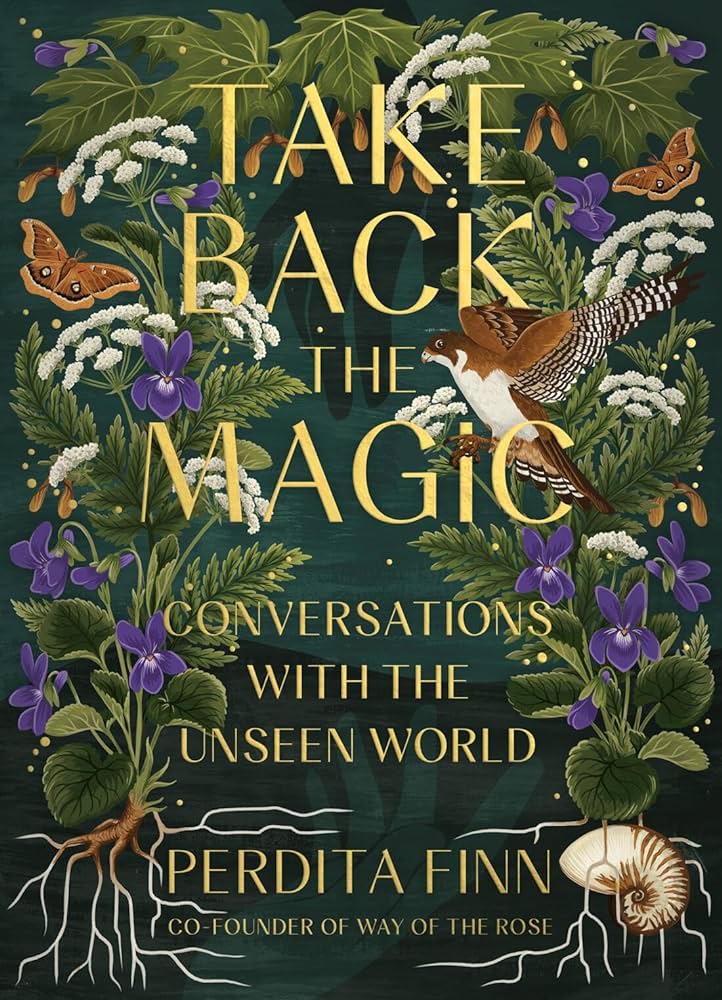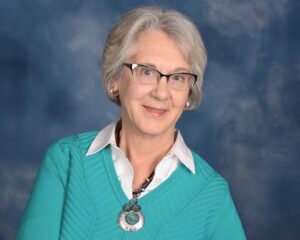Reviewed by Sandra Eliason
 At the beginning of Perdita Finn’s Take Back the Magic: Conversations With the Unseen World, she informs the reader that her book is an invitation “to reconnect with their own inner knowing and to call forth magic from the land of the dead.” She describes “the story of my own underworld journey and the miracles of healing that happened between my father and me long after he died.”
At the beginning of Perdita Finn’s Take Back the Magic: Conversations With the Unseen World, she informs the reader that her book is an invitation “to reconnect with their own inner knowing and to call forth magic from the land of the dead.” She describes “the story of my own underworld journey and the miracles of healing that happened between my father and me long after he died.”
After Finn’s father died, she received her inheritance in the mail: a small jet-black rock circled by twisted iron rods. He left her nothing else; in fact, she and her two siblings were specifically cut out of his will. Finn wasn’t going to let this “gift” be his last word. She began to write him letters, letting him know she had been and continued to be in conversations with the dead, and she felt their presence.
The following chapters alternate between a memoir of Finn’s life, describing her journey to communion with the dead, and letters to her father, reviewing his life and their relationship. Early on, Finn compares her father’s occupation as a surgeon to the religion he so vehemently opposed:
“medicine, science itself, was just another priesthood with conservative creeds and rigid hierarchies? You fled one institution and found yourself in another.”
Interspersed among the letters are chapters addressed to the reader, discussing how to “create a space for the dead in our lives,” with answers to questions such as What if I make a mistake and the souls of the departed I’m seeking don’t like it?; and providing instructions such as using our own sensory experiences to call upon the dead. “None of us needs to manage life on our own,” she says, “Our ancestors are standing by to help us.”
Much of Finn’s writing is lyrical, in passages such as:
“Beneath us and behind us, all around us, are mysteries. We send out probes into space and shatter atoms to see how they are made. But our most adventurous scientists only discover what the mystics always knew—the cosmos is stranger than we can possibly imagine. Light bends. Time folds. One world gives birth to another. An electron can be in two places at once. Most of the universe is dark matter, and we have no idea what that is. In truth, most of what we are is dark matter.”
The author’s spiritual journey began in a Zen monastery after she and her husband Clark moved to Woodstock, New York. She dropped out when a head monk complained about her baby’s cooing. Attending an Episcopal church later, she found the patriarchal lineages of both the churches to be inauthentic. After a tornado blew over 60 trees on her property and she and Clark observe the tangled roots, Finn asks: “Where in the Buddha’s lineage…was the mother who bore him? Where was the tree she clutched in the throes of labor?…. Lineages are a lie. Each of us arises from entangled root systems. My spiritual home was in the earth.”
After she births her first daughter, Finn is convinced this daughter is the same soul who had tried to come to her earlier; she reveals that she and her husband have met many children who still cling to memories from other incarnations. Throughout Take Back the Magic, Finn details other incidents and encounters that convince her of the ability to commune with the dead.
An example: When Finn unexpectedly comes across the rock her father left her, she finds a blacksmith to take off the iron encircling it, revealing a beautiful rock with flecks of white, like stars. At the same time, Clark reads a book on Kali worship in India, which says, “Although the goddess’s power may be found in temples, burning grounds, and other sacred places, very frequently it is found in black, rounded stones.” Of this Finn writes:
“My impossible, infuriating, difficult, curmudgeonly father had somehow bequeathed to me, from beyond the grave, a dark jewel. He had sent me the one thing I had always wanted from him . . . an acknowledgment that we were both devoted to the Lady, that our souls were entangled forever in the body of her love, and that love itself was real and everlasting and would never vanish.”
In Take Back the Magic, Finn makes a stepwise claim to gaining knowledge of the dead, who surround us—and to finding mysticism not in the gods of the patriarchy, but in the wisdom of a Madonna. Above all, her book is a testament to the joys that guide us from one lifetime to the next.
 Sandra Eliason is a retired doctor who has turned to writing full time. In 2016, she won the Minnesota Medicine Magazine Arts Edition writing contest. Since then she has taken multiple writing classes, gone to conferences, joined writers’ groups and worked to hone her craft.
Sandra Eliason is a retired doctor who has turned to writing full time. In 2016, she won the Minnesota Medicine Magazine Arts Edition writing contest. Since then she has taken multiple writing classes, gone to conferences, joined writers’ groups and worked to hone her craft.
Sandra has been published in Bluestem magazine, the Brevity blog, been anthologized in the e-book Tales From Six Feet Apart, and has an upcoming piece in West Trade Review (April). She is querying her completed memoir, Heal Me—Becoming a Doctor for all the Wrong Reasons (and Finding Myself Anyway).You can find her in Minneapolis, Minnesota, where she lives with her husband. She has a garden in the summer and a cat to warm her lap in the winter. Look for her on Twitter @SandraHEliason1 or Instagram @sheliasonmd.


